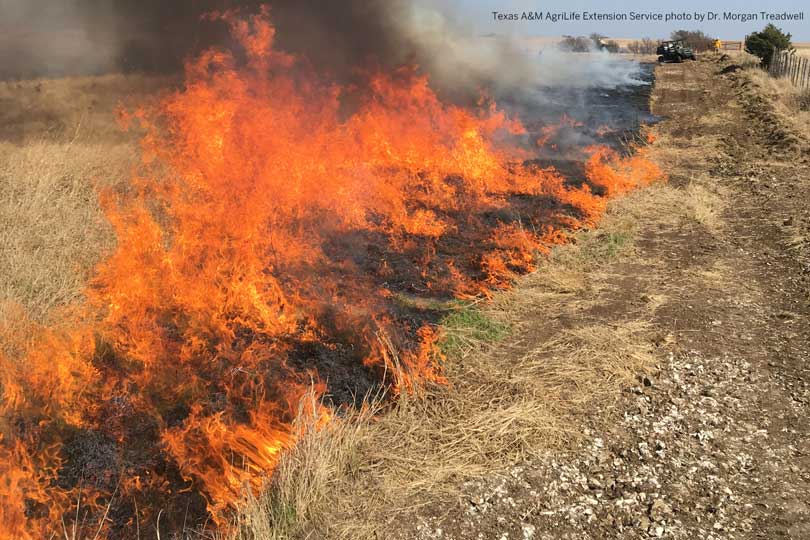By Jessica Domel
Multimedia Reporter
The sight of smoke and flames strikes fear in most Texans’ hearts. But fire, if used correctly, can be a valuable tool that curbs invasive species and restores native grasses.
Prescribed burns can aid in habitat restoration, rangeland restoration and wildfire mitigation, according to Dr. Morgan Treadwell, Texas A&M AgriLife Extension Service range specialist.
“It’s almost impossible, I believe, to manage working lands, rangelands, in Texas without factoring fire somewhere into the equation,” Treadwell said.
Ranchers have two choices regarding fire control, Treadwell explained. They can either experience a wildfire by reacting to it or they can implement a prescribed burn and be proactive.
“We, anywhere in the state of Texas, evolved with the historical fire return anywhere from two to 20 years,” Treadwell said. “We know this landscape is used to frequent and routine burning. When we suppress fires, what we’re doing is just almost increasing the problem to the point where Mother Nature will find a way to burn on her own with those enormous accumulated fuel loads.”
Prescribed burns allow landowners to essentially fireproof rangeland pastures through a holistic manner with a natural evolutionary process like fire.
“Then we see increases in native species diversity,” Treadwell said. “We also see exotic or invasive species suppressed.”
Those species are not completely eradicated with a prescribed burn, but the fire does train pastures to become more natural in terms of species diversity and composition.
Conducting a prescribed burn is more than simply lighting a fire.
It takes planning and careful consideration.
“I recommend that folks who are thinking about a prescribed burn really get a solid grazing rotation program down,” Treadwell said.
Ranchers should consider what they’ll do with livestock before, during and after a pasture is burned.
“Having an overall ranch management plan that factors in a grazing plan and also a prescribed burn plan and even drought, too, is where it should all start,” Treadwell said. “The planning really needs to come full circle before you start making calls to get a prescribed burn implemented on your place.”
Not all areas are ideal for a prescribed burn. The landowner, farmer or rancher, pasture and location should all be considered before any burn is implemented.
“I like to say there is always a time and a place for prescribed burning,” Treadwell said. “We see constant fluctuations in dry times or even in rainy times, as well.”
If using a burn to control brush, hotter, drier conditions may be more beneficial for a prescribed burn, but there are exceptions.
“If you’re in a forage shortage situation, you’re up against the wall in terms of pastures for grazing in the future, especially come winter, then maybe you need to rethink the timing,” Treadwell said.
Prescribed burns should fit in with a grazing plan and a landowner or ranchers’ overall burn objectives.
In some areas, a prescribed burn is just not a good idea no matter the time of year.
“Sometimes in heavy wildland-urban interface areas, where there’s a lot of fragmentation from housing, fire in that environment may not be the best resource we have,” Treadwell said. “We have other tools in our toolbox to manage for brush and also increase native grass diversity.”
Treadwell encourages anyone contemplating a burn to do their homework, research liability and insurance options for prescribed burning.
“Odds are, if you’re dealing with those types of issues, you really want to make sure all your ducks are in a row before talking about prescribed burning or implementing a plan,” Treadwell said.
Some landowners implementing a burn create door hangers notifying their neighbors of a pending burn. Others alert the local TV station or newspaper so drivers and people nearby are aware.
“Increasing awareness of what you’re doing and why is always really important,” Treadwell said.
Treadwell and Extension host workshops on prescribed burns each year. To sign up for Treadwell’s email list to receive information on upcoming classes, email morgan.treadwell@ag.tamu.edu or visit

